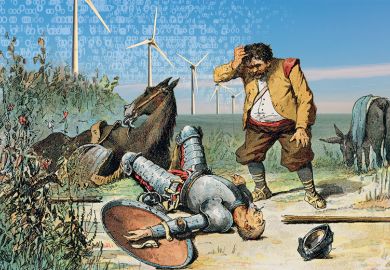Anyone seeking reliable and up-to-date information on South Asian languages will want to turn to this exhaustive reference collection, says Asko Parpola
There are two major publication series devoted to up-to-date descriptions of languages and language families: the Cambridge Language Surveys and the Routledge Language Family series. Colin Masica's The Indo-Aryan Languages appeared in the Cambridge series in 1991. Now a book with the same title has been published in the Routledge series, edited by George Cardona and Dhanesh Jain.
Despite their identical titles, the two books are not identical in conception, but fruitfully complement each other. Masica's work is basically a topically arranged comparative study of linguistic phenomena within this language group written by a single scholar. The book edited by Cardona and Jain is a collective effort by 23 scholars, organised on a language-by-language basis. Masica continues along the trail blazed by John Beames' A Comparative Grammar of the Modern Aryan Languages of India (1872-79) and Jules Bloch's L'Indo-Aryen du Veda aux Temps Modernes (1934), which was revised in Alfred Master's English translation in 1965. Cardona and Jain offer a handy and reasonably sized updating of Sir George Grierson's celebrated Linguistic Survey of India (11 volumes in 19 parts, mostly dealing with Indo-Aryan, 1903-28).
Some other recent reference works, such as The Encyclopaedia of Language and Linguistics (ten volumes, 1994), contain succinct but scattered modern descriptions of the Indo-Aryan languages. Cardona and Jain's volume has much more detailed descriptions: on average, each article is 41 pages long.
Such space allows a relatively comprehensive treatment, supplemented by a bibliography of literature quoted and suggested further reading. (Helmut Nespital's Dictionary of Hindi Verbs (1997) could be added.) The editors have striven to recruit the best available experts with laudable results, even if some gaps remain - "it is hard to find scholars to compose acceptable contemporary descriptions of... the languages of Rajasthan and Pahari languages". And though the editors stress that they do not always agree with individual authors in their judgements of data, this is a very useful handbook for linguists and for anyone seeking reliable linguistic or sociolinguistic information on South Asian languages.
The general introduction, by both editors, opens with statistics of the numbers of Indo-Aryan language speakers in 1991 and projections for 2001 (the book appeared in 2003 but was completed before the 2001 census), and a short note on multilingualism across language families, written by Jain.
From this it is clear that the Indo-Aryan languages now have more than 1 billion speakers (Hindi alone has more than 420 million speakers). They belong to the Indo-European language family, the world leader not only in numbers of speakers but also in regard to geographical spread and influence. In South Asia, the Indo-Aryan languages accounted for 78.5 per cent of speakers in 1991, while the portion of Dravidian language family speakers (in south India) was 17.5 per cent; the remaining 4 per cent of the South Asian population speak Tibeto-Burman (in the north and the east), Austro-Asiatic (in central and eastern India) and Iranian languages (in the northwest).
Cardona then writes the rest of the general introduction. He deals with the developmental stages of Indo-Aryan and their major characteristics; the sub-groups of the Indo-Aryan languages; relations with other Indo-European languages, in particular with the Iranian and Nuristani languages (with which Indo-Aryan constitutes the Indo-Iranian sub-family); the relations with non-Indo-European languages and the influence they have exerted on Indo-Aryan (particularly the problem of retroflex consonants); and that most controversial question - the nature of the Indo-Aryan homeland.
The history of this was last well delineated by Edwin Bryant in The Quest for the Origins of Vedic Culture: The Indo-Aryan Migration Debate (2001).
In Western research, the idea that the Indo-Aryan language and the Vedic culture came to South Asia from Central Asia and beyond during the second millennium BC has been taken as rather well established. But in recent years, the view has been challenged. It has often been labelled colonialist propaganda, mainly by supporters of Hindu political and religious nationalism, most of them writers with minimal academic credentials although they include some scholars (a few of them Western). This rather vociferous opposition claims that the Indo-Aryans have been in South Asia since time immemorial, certainly before the Indus civilisation of c.
2600-1900BC, which according to them was Indo-Aryan speaking; and they often imply that South Asia is the homeland of the whole Indo-European language family. Several authorities, including Hans Henrich Hock and now Cardona, have given these claims perhaps more attention than they deserve, to demonstrate that they have an unsubstantiated or mistaken basis.
Correlating archaeology with textual and linguistic evidence relating to the emergence, dispersal and external contacts of the Indo-European and Indo-Iranian proto-languages has been at the forefront of my own researches in the past three decades. Given that Cardona himself has expressed to me his regret that this book could not make use of my recent papers, I hope readers will excuse me if I briefly note that they are to be found in Early Contacts between Uralic and Indo-European (2001), edited by Christian Carpelan et al ; Indo-Iranian Languages and Peoples (2002), edited by Nicholas Sims-Williams; Iranica Antiqua , volume 37 (2002); and the Journal of the American Oriental Society , volume 122 (2002).
To rebut the claims of the nationalists, an unbroken succession of archaeological cultures can be quoted that take the different branches of the Indo-European language family to the areas where they are first historically recorded, beginning with the Pontic steppes, north of the Black Sea, starting from about 3500BC, when wheeled vehicles were first invented. At least five different terms relating to wheeled vehicles can be reconstructed for the proto-Indo-European language, which thus could not have split before this date. About 100 Indo-European loan words were taken over into the Finno-Ugric proto-language in northeastern Europe in a period that, according to phonological criteria, spanned from proto-Indo-European to early proto-Aryan, early proto-Indo-Aryan and early proto-Iranian.
The most probable homeland of the Indo-Aryan languages was on the middle and lower Volga (Abashevo culture, c. 2500-2000BC) and in the southern Urals (Sintashta-Arkaim culture, c. 2200-1800BC). The earliest archaeological evidence of horse-drawn chariots is from the latter area, dating to c. 2000BC. From there, the domesticated horse and the Indo-Aryan language seem to have entered South Asia in the Gandhara grave culture of north Pakistan around 1600BC, about the same time as Indo-Aryan speaking chariot-warriors took over the power in the Mitanni kingdom in Syria. Both the Gandhara grave culture and the Mitanni Aryans can be traced back to the Bronze Age culture of Bactria and Margiana (in Turkmenistan, Tajikistan and Afghanistan), which received the horse-drawn chariot and apparently also an Indo-Aryan speaking aristocracy from the northern steppes in the beginning of the second millennium BC.
Apart from the general introduction, there is one other chapter of a general character, that in which Jain writes on the sociolinguistics of the Indo-Aryan languages. The main topics are the status of Sanskrit and the different Prakrits; which social groups use which language according to the grammarians, rhetoricians and the dramas; the role and use of script; multilingualism in South Asia; language maintenance and language shift; language use in Delhi courts; language planning; the census of India as a language database; and pronominal use in ethnography of speaking.
The other chapters, dealing with specific languages, open with a hierarchical analysis of the contents allowing a quick orientation; the tables and figures are also enumerated. Some analyses are more detailed than others. Chapter seven on Hindi (36 pages), by Michael C. Shapiro, for example, has the following headings: "1 Introduction, 2 Major dialects and classification within Indo-Aryan, 3 Registers and styles of the language, 4 Literary traditions and linguistic development, 5 Script, phonetics and phonology, 6 Morphology and syntax, 7 Lexicon, 8 Discourse grammar, 9 Historical developments." Only heading 6 has further subheadings. This chapter has nine tables: on vowel phonemes, consonant phonemes, noun declensions, adjective declensions, pronominal paradigms, forms of the copula ( hona ) "to be", aspectual verb forms, non-aspectual verb forms and morphologically related verb sets. While this conspectus takes less than a page, the contents of chapter eight on Urdu (65 pages), by Ruth Laila Schmidt, occupies almost three pages and has subheadings up to the fifth level.
In addition to Hindi and Urdu, the national languages of India and Pakistan respectively, the book describes the following modern Indo-Aryan languages: Bangla (spoken in West Bengal and Bangla Desh), Asamiya (in Assam), Oriya (in Orissa), Maithili, Magahi (Magadhi), Bhojpuri (these three spoken in the Gangetic plains south of central and eastern Nepal), Nepali, Panjabi, Sindhi, Gujarati, Marathi (in Maharashtra), Konkani (around Goa), Sinhala (in Sri Lanka), Dardic and Kashmiri. Actually, Dardic is not a single language but a group of fairly archaic tongues, which, excepting Kashmiri, are small and spoken in northern Pakistan. Elena Bashir's chapter on Dardic is the longest in the book (77 pages), which is justified by the fact that there are 16 Dardic languages and by a lot of new information that she makes available.
The scope of the book is not restricted to Modern Indo-Aryan. Cardona describes Old Indo-Aryan or Sanskrit (Vedic and classical), while Middle Indo-Aryan or Prakrit is dealt with in two sections. Thomas Oberlies writes on the Asokan inscriptions and Pali, the language of the southern, or Theravada, Buddhism. Vit Bubenik describes the literary and theatrical Prakrits, the Prakrits used by Jainas, the Pais'aci Prakrit and the late stage of Middle Indo-Aryan called Apabhrams'a.
Most articles discuss - with charts - even the script(s) in which the language is written. In addition, there is a separate chapter, by Richard Salomon, dealing with all the writing systems of the Indo-Aryan languages and their evolution. It thus covers also the Brahmi and Kharoshthi scripts used in the earliest directly preserved Indo-Aryan texts, the inscriptions of the Emperor Asoka (who reigned 268-232BC).
This carefully produced book is an important reference work. It contains throughout a lot of information hard to find elsewhere, and the three indexes (general, language-wise and sources of passages cited) make this wealth of data easily accessible.
Asko Parpola is professor of Indology, University of Helsinki, Finland.
The Indo-Aryan Languages
Editor - George Cardona and Dhanesh Jain
Publisher - Routledge
Pages - 1061
Price - £180.00
ISBN - 0 7007 1130 9
Register to continue
Why register?
- Registration is free and only takes a moment
- Once registered, you can read 3 articles a month
- Sign up for our newsletter
Subscribe
Or subscribe for unlimited access to:
- Unlimited access to news, views, insights & reviews
- Digital editions
- Digital access to THE’s university and college rankings analysis
Already registered or a current subscriber? Login



